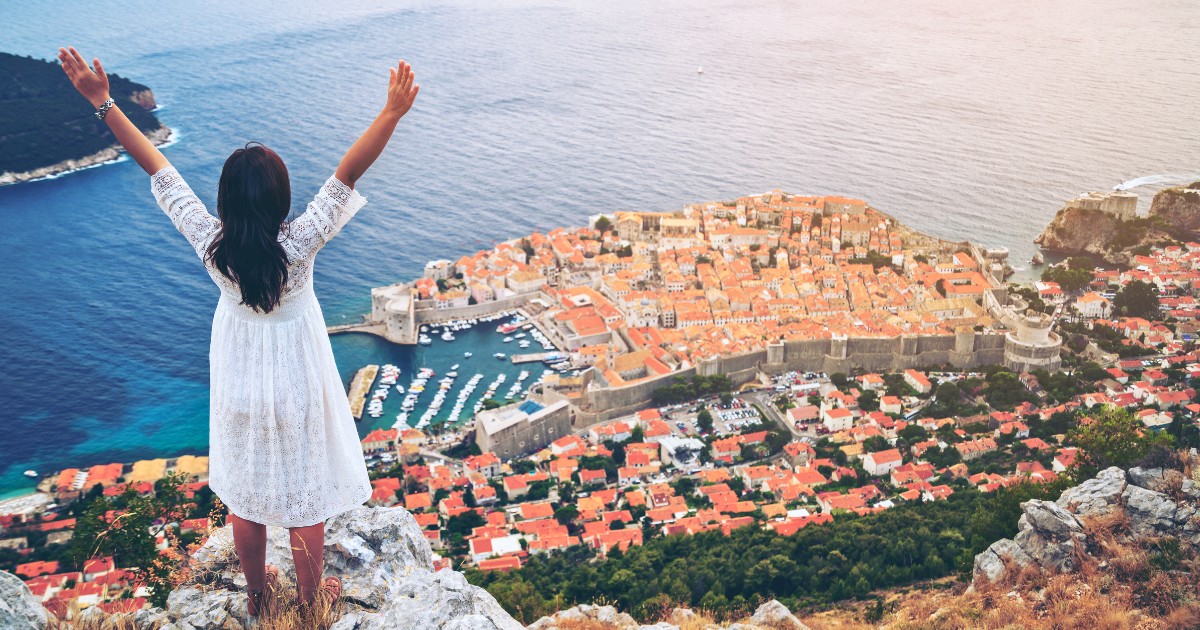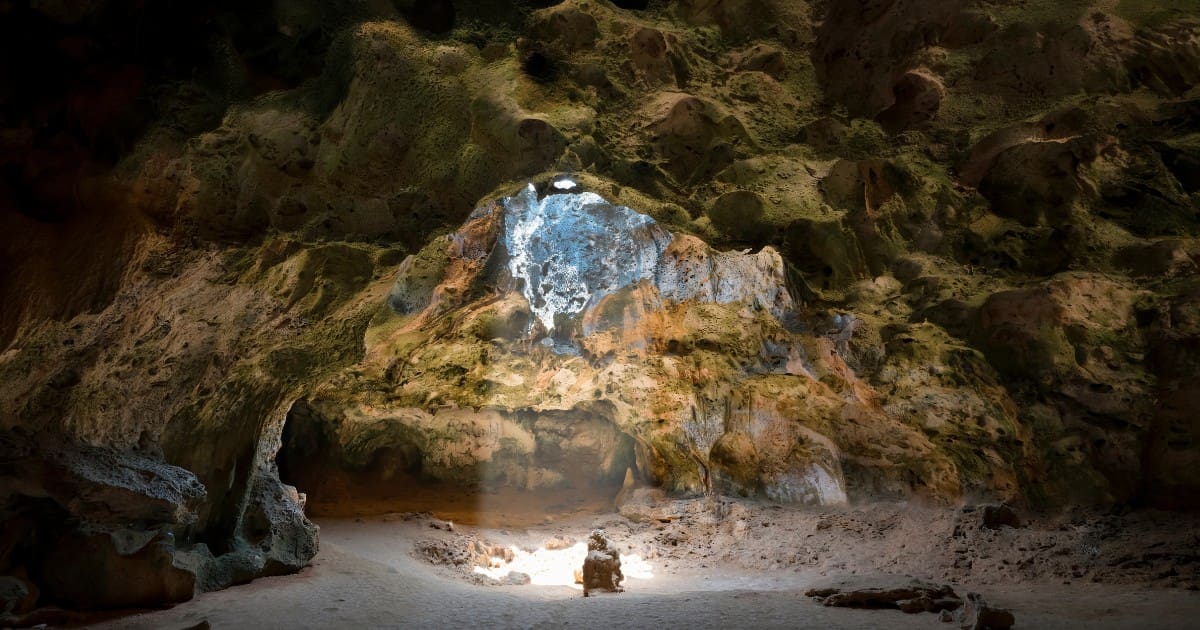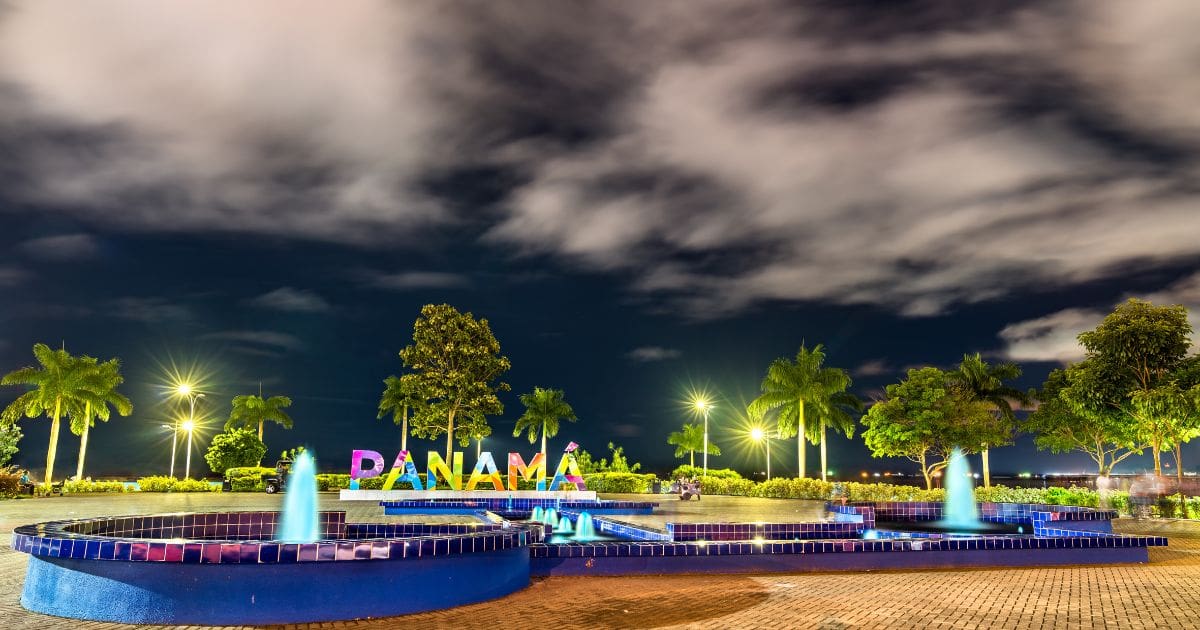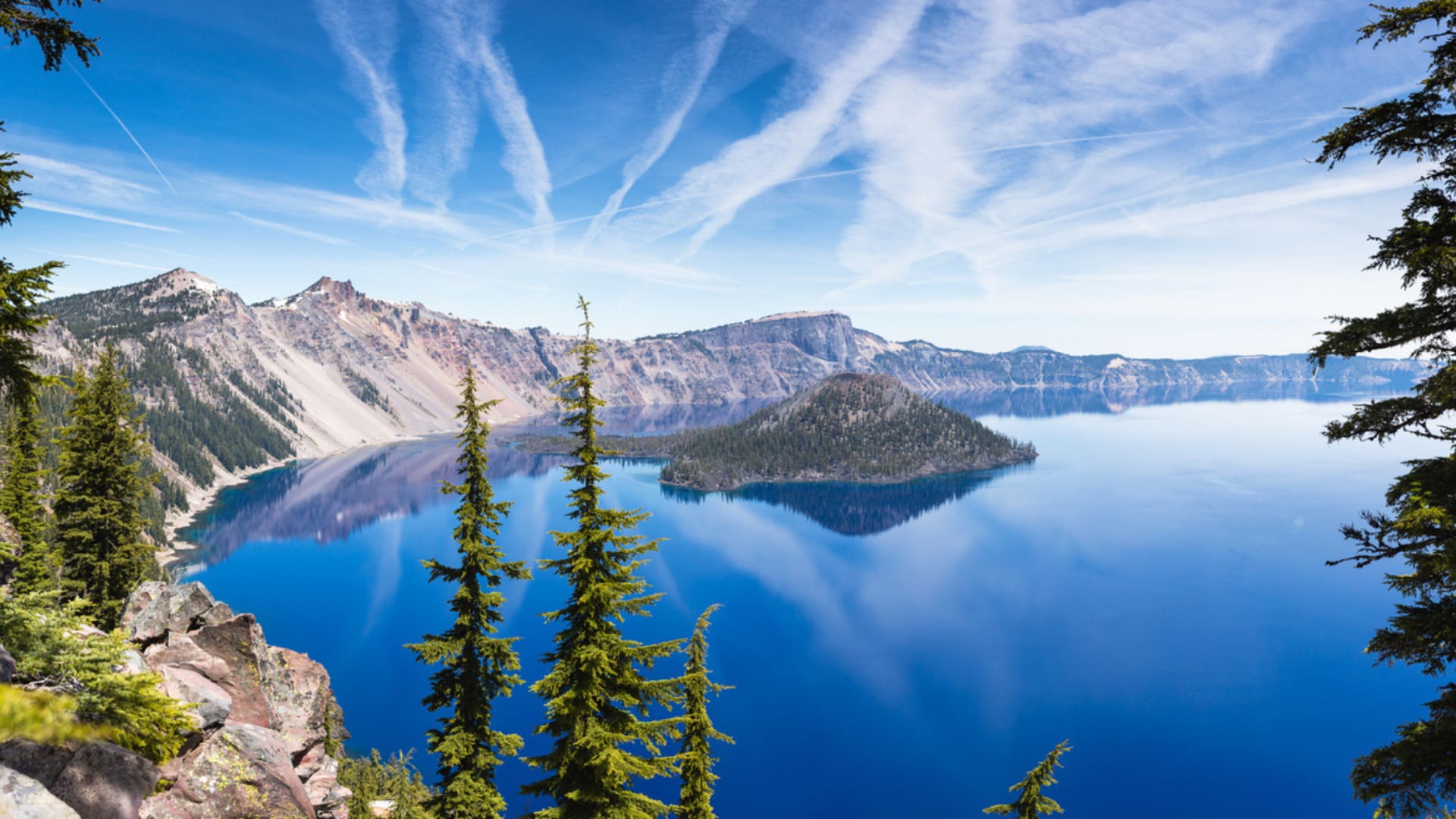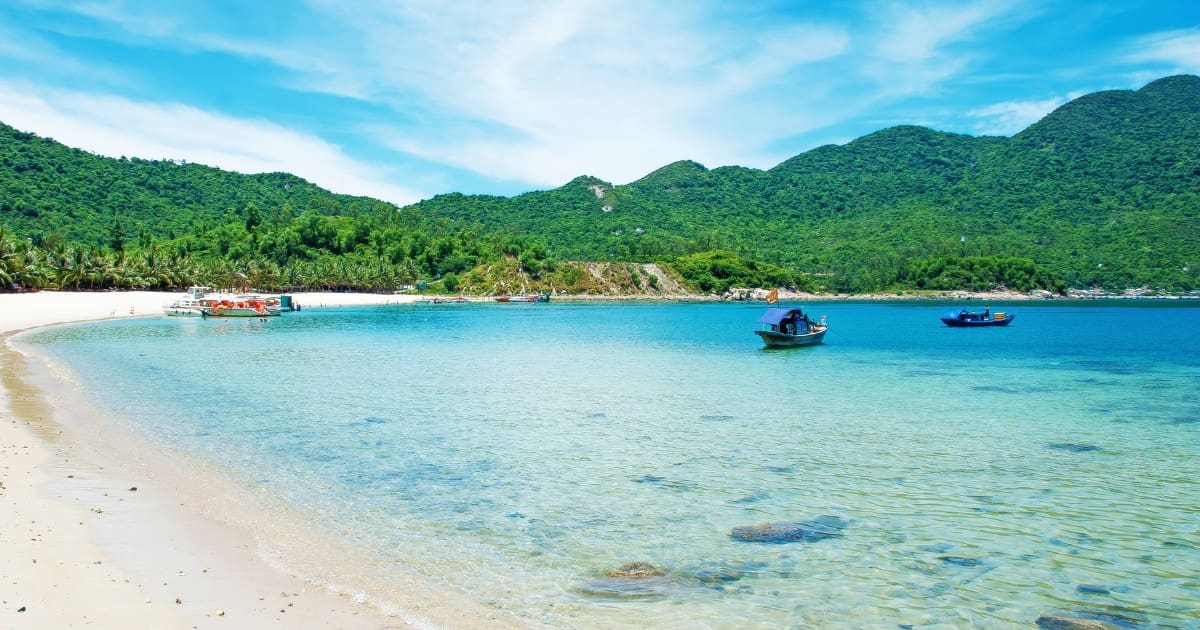I’ve visited Croatia five times, and every trip leaves me more in love with this amazing country. From its bustling cities to its stunning coastline, Croatia never fails to amaze me. Did you know that in 2023 alone, there are 20.6 million people visited Croatia? That’s a lot of happy travelers!
Today, I’ll share my favorite cost-efficient one-week Croatia itinerary with you. You’ll start in the exciting capital city of Zagreb and end up in beautiful Dubrovnik by the sea. Along the way, you’ll see waterfalls, explore ancient ruins, and relax on gorgeous beaches. I can’t wait to show you the best of Croatia!
Why Croatia is an Awesome Travel Destination
Croatia stole my heart from the moment I first set foot in this diverse country. It’s a travel destination where history and nature blend seamlessly, offering something for everyone.
I love how you can explore ancient Roman ruins in the morning and relax on a pristine beach in the afternoon. The food is mouthwatering, featuring fresh seafood and hearty inland dishes. And the people? They’re some of the most welcoming I’ve met in all my travels.
What truly sets Croatia apart is its incredible variety. In just one week, you can explore a vibrant capital city, a national park with breathtaking waterfalls, ancient coastal towns, gorgeous islands, and a city with massive medieval walls.
What You’ll See and Do in One Week Croatia Itinerary
I’ve carefully planned this Croatia itinerary to give you a taste of everything Croatia has to offer. Here’s a quick overview of our action-packed week:
| Day | Destination | What You’ll Do |
|---|---|---|
| 1 | Zagreb | Explore the capital’s charming streets and markets |
| 2 | Plitvice Lakes | Hike through stunning waterfalls and lakes |
| 3 | Split | Discover an ancient Roman palace by the sea |
| 4 | Hvar | Island-hop and enjoy beautiful beaches |
| 5 | Blue Cave | Take a boat tour to see natural wonders |
| 6-7 | Dubrovnik | Walk the famous walls and explore the old town |
Each day in this Croatia itinerary is filled with unique experiences that I’ve personally enjoyed and I’ll share then with you. From tasting local delicacies to swimming in crystal-clear waters, we’ll make memories that’ll last a lifetime.
Get Ready: Tips for Your Croatia Trip
Before we begin our day-by-day adventure, let me give you some essential information before visiting Croatia. These travel tips will help you make the most of your time in Croatia and ensure a smooth, enjoyable trip.
Best Times to Visit Croatia
In my experience, the best time to visit Croatia depends on what you’re looking for. Here’s a breakdown of what to expect in each season:
| Season | Months | Weather | Crowds | Prices | Activities |
|---|---|---|---|---|---|
| Spring | March-May | Mild, some rain | Low | Lower | Sightseeing, hiking |
| Summer | June-August | Hot, sunny | Very high | Highest | Beach, water sports |
| Fall | September-November | Mild, some rain | Low | Lower | Festivals, wine tasting |
| Winter | December-February | Cold, possible snow | Very low | Lowest | Skiing, Christmas markets |
I personally love visiting Croatia in September because the weather is still warm, the sea is perfect for swimming, and the summer crowds have thinned out. Plus, prices start to drop after the peak season so you’ll get to enjoy all the best parts of summer without the drawbacks.
How to Get Around Croatia: Buses, Boats, and Cars
Getting around Croatia is pretty straightforward. Here are the main transportation options you’ll use during your trip:
- Buses: This is how you’ll travel for most of this trip. Croatian buses are comfortable and reliable. They connect all major cities and towns and often offer beautiful coastal views.
- Boats: To reach the islands, you’ll use ferries. These range from large car ferries to faster catamarans for foot passengers. The boat rides are an experience in themselves, offering stunning views of the coastline.
- Cars: While you won’t use one on this Croatia trip, renting a car can be a good option if you want more flexibility. Just be prepared for narrow roads in some areas and limited parking in old town centers.
- Planes: For longer distances, you can fly between major cities. However, for our one-week itinerary, we’ll stick to ground and sea transportation to maximize your sightseeing opportunities.
I find that using buses and boats gives you a chance to relax and enjoy the scenery. Plus, you don’t have to worry about parking, which can be tricky in old town centers. It’s also a great way to meet other travelers and locals!
Estimated Costs for One Week Travel in Croatia
Here’s a breakdown of what I usually spend on a week-long trip to Croatia. Keep in mind prices can change and everyone travels differently, but this should give you a good idea:
| What For | How Much (in Euros) | What’s Included |
|---|---|---|
| Place to Sleep | 400 – 800 | Hostels to mid-range hotels |
| Getting Around | 150 – 250 | Buses, ferries, and local transport |
| Food and Drinks | 200 – 400 | Mix of self-catering and restaurants |
| Fun Stuff to Do | 100 – 200 | Entrance fees, tours, activities |
| Extra Things | 50 – 100 | Souvenirs, miscellaneous expenses |
| Total | 900 – 1750 | Per person, excluding flights |
Remember, if you visit in the busy summer months (July and August), things might cost more. Spring or fall can be easier on your wallet. Don’t forget to check current prices when you’re planning. Prices can change, but Croatia is always worth it!
What to Pack for Your Week in Croatia
Packing right can make your trip to Croatia so much more enjoyable. Here’s what I always make sure to bring:
- Comfortable walking shoes: You’ll be doing a lot of walking on cobblestone streets and nature trails. Break them in before the trip to avoid blisters.
- Swimsuit and quick-dry towel: For beach days and swimming in waterfalls. The quick-dry towel is a lifesaver when you’re on the move.
- Sunscreen, sunglasses, and a hat: The Croatian sun can be strong, especially on the coast. Protect your skin to enjoy the outdoors fully.
- Light, breathable clothes: For warm days, wear light clothes, plus a light jacket for cooler evenings. Layers are key for adjusting to temperature changes.
- Daypack: To carry water, snacks, and essentials on your daily adventures. Choose one that’s comfortable for long days of exploring Croatia.
- Adapter plug: Croatia uses the standard European two-pin socket. Bring an adapter to keep your devices charged.
- Reusable water bottle: Tap water is safe to drink throughout Croatia. You’ll save money and reduce plastic waste.
Remember, you can buy most things you might forget in Croatia, so don’t stress too much about packing. Focus on bringing the essentials and leave some room in your luggage for souvenirs!
Now that we’re prepared let’s start bringing to life our Croatia itinerary in the capital city, Zagreb. I can’t wait to show you the hidden gems and local favorites I’ve discovered over my many visits to this charming city.
Day 1: Explore Zagreb, Croatia’s Big City
Our journey begins in Zagreb, Croatia’s capital and largest city. I love starting trips here because it gives you a great introduction to Croatian culture and history. Plus, it’s less touristy than the coast, so you get a more authentic experience.
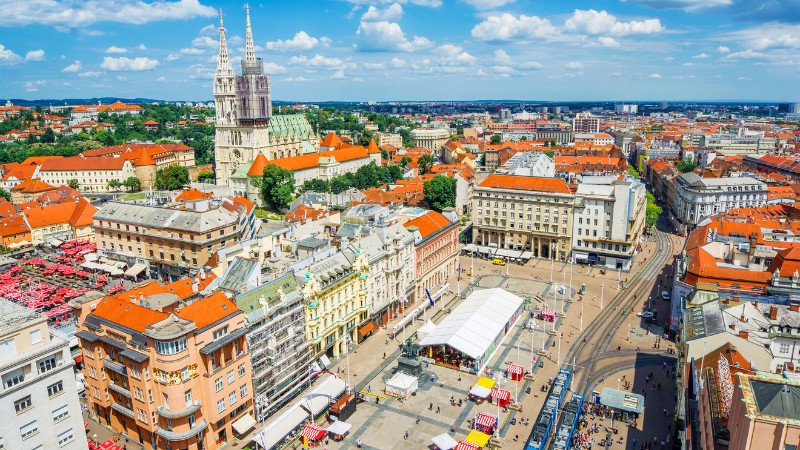
Walk Through Zagreb’s Old Streets
After you’ve settled into your hotel, head out to explore the Upper Town, Zagreb’s historic core. This area is filled with cobblestone streets, colorful buildings, and centuries of history. Here’s what you’ll see:
- St. Mark’s Church: This 13th-century church is famous for its colorful tiled roof depicting the coat of arms of Zagreb and Croatia. It’s truly a unique sight that you won’t find anywhere else in the world.
- Stone Gate: This gate houses a painting of the Virgin Mary that miraculously survived a fire in 1731. Locals often stop to light candles and say a prayer, which is a touching glimpse into local Croatian traditions.
- Lotrščak Tower: If you time it right, you can hear the noon cannon fire that’s been a Zagreb tradition since the 19th century. The boom echoes through the city, marking midday for everyone.
As you walk, you’ll see the gas lamps that still light the streets at night, just like they did over a century ago. These lamps are lit manually every evening, adding to the city’s old-world charm. It’s details like these that make Zagreb feel like a living museum.
Try Local Food at the Big Market
Now that you’ve worked up an appetite, head to Dolac Market. This open-air market has been the city’s major trading place for decades. It’s where locals come to buy fresh Croatian produce, meat, and dairy products. Here’s what to look out for:
- Red umbrellas: These shade the stands and have become a symbol of the market in Croatia, which create a colorful canopy that’s perfect for photos.
- Fresh produce: Look for local Croatian specialties like šljive (plums) and jagode (strawberries). The fruits and vegetables here are incredibly fresh and flavorful.
- Kumica statue: This bronze statue honors the market women who’ve been selling here for generations. It’s a testament to the market’s long history and importance to the city.
After exploring the market, grab lunch nearby. I recommend trying štrukli, a local pastry dish filled with cheese. It’s delicious and gives you a taste of traditional Zagreb cuisine. The soft, pillowy dough and rich cheese filling are comfort food at its best.
Have Fun in the City at Night
As evening falls, Zagreb takes on a different character. The streets light up, and people come out to enjoy the cooler air. Here’s how you can spend your evening:
- Tkalčićeva Street: This pedestrian street is lined with cafes and bars perfect for people-watching and soaking in the local atmosphere.
- Zagreb 360° Observation Deck: For a spectacular view of the city at night, you can head up to this viewpoint. On a clear night, you can see for miles!
- Try some local craft beer: Croatia has a growing craft beer scene, and Zagreb is at its heart. The bartenders are always happy to explain the different styles and help you find one you’ll love.
Day 2: See the Amazing Waterfalls at Plitvice Lakes
Today, we’re visiting a place that never fails to take my breath away – Plitvice Lakes National Park. It’s a UNESCO World Heritage site and, in my opinion, one of the most beautiful places in Europe.
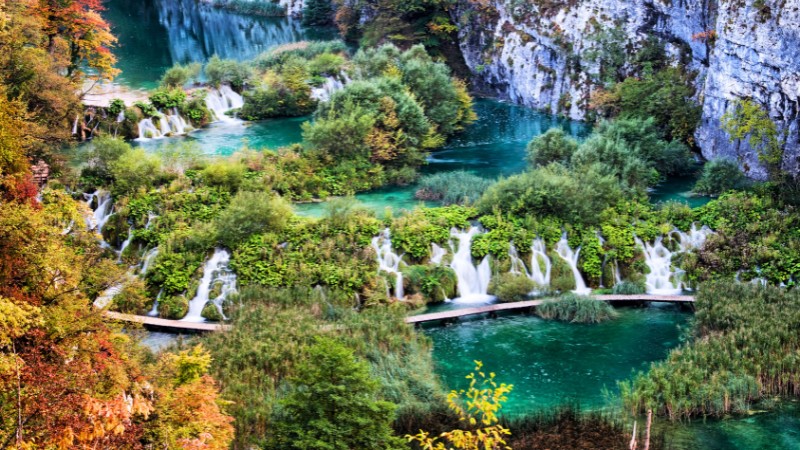
How to Get from Zagreb to Plitvice Lakes
Start your day early with a bus ride from Zagreb to Plitvice Lakes. Here’s what you need to know:
- The journey takes about 2 hours and 20 minutes.
- Buses leave from Zagreb’s main bus station, which is easy to find in the city center.
- I recommend buying tickets a day in advance to secure our seats. The bus can get crowded, especially in summer.
- Bring some snacks and water for the trip. There’s a small cafe at the bus station if you need to grab something quick.
The ride itself is quite scenic, taking you through the Croatian countryside. I always enjoy watching the landscape change as we get closer to the park.
You’ll see rolling hills, forests, and small villages along the way. It’s a great chance to see a different side of Croatia.
Walk on Paths Over Beautiful Blue Lakes
Once you arrive at Plitvice, prepare to be amazed. The park is a series of 16 lakes connected by waterfalls, and you’ll explore it via a network of wooden walkways. Here’s what you’ll see:
- Lower Lakes: Start with the lower section of the park, where the walkways take you right over the water, giving you an up-close view of the waterfalls.
- Veliki Slap: This is the Plitvice Lakes National Park’s largest waterfall at 78 meters high. The roar of the water is impressive!
- Upper Lakes: After lunch, explore the upper section. These lakes are larger and surrounded by dense forests. The colors here range from deep blue to emerald green depending on the minerals in the water.
- Boat ride: A short electric boat ride across the largest lake, Kozjak, is included in your ticket. It’s a peaceful way to take in the scenery and rest your feet.
As you walk Plitvice Lakes National Park, keep an eye out for wildlife. I’ve spotted everything from colorful birds to shy deer on my visits here. The park is also home to brown bears, though they usually stay away from the tourist areas.
Take Instagrammable Pictures of the Waterfalls
Plitvice Lakes is a photographer’s dream, but even if you’re just using your phone, you’re sure to get some amazing shots. Here are my tips for great photos:
- Use the walkways as a frame: They add interesting lines to your composition and give a sense of scale to the waterfalls.
- Capture the turquoise water: The lakes’ color is incredible, especially on a sunny day. Try to include some of the surrounding greenery for contrast.
- Try long exposures of waterfalls: If you have a camera that allows it, slow shutter speeds can create a dreamy, silky effect on the water.
- Don’t forget the details: Close-ups of water droplets on leaves or the patterns in the travertine barriers can be just as beautiful as wide shots.
Remember, while getting good photos is fun, make sure to take time to just enjoy the beauty around you. Some of my best memories of Plitvice are moments when I put the camera down and just soaked in the scenery.
Practical Tips for Visiting Plitvice Lakes
To make the most of your visit, here are some important things to keep in mind:
- Wear comfortable, sturdy shoes with good grip. The walkways can get slippery when wet.
- Bring a water bottle. You can refill it at water fountains throughout the park.
- Pack a light raincoat or poncho, even on sunny days. The mist from the waterfalls can get you wet!
- Follow the marked trails and don’t stray off the paths. This is for your safety and to protect the delicate ecosystem.
- The park can get crowded, especially in summer. Starting early helps you avoid the biggest crowds.
Day 3: Visit Split and Its Old Roman Palace
On the third day of your Croatia itinerary, head to the Dalmatian coast to explore Split, Croatia’s second-largest city. Split is famous for its Roman ruins, beautiful beaches, and bustling waterfront.
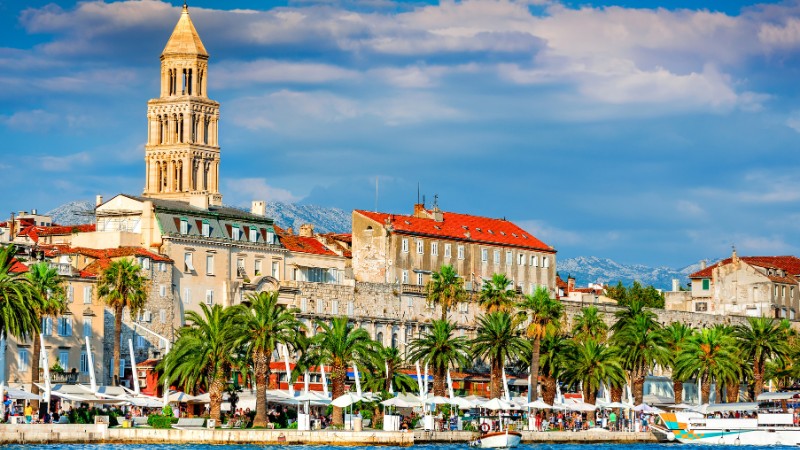
Travel from Plitvice to Split
Start your day with a bus ride from Plitvice to Split. Here’s what you need to know:
- The journey takes about 4 hours, depending on traffic.
- Buses usually leave in the morning, giving us plenty of time to explore Split in the afternoon.
- The route takes us through some beautiful mountain scenery before reaching the coast.
- I recommend sitting on the right side of the bus for the best views of the Adriatic Sea as you approach Split.
During the ride, you’ll notice the landscape changing dramatically. It’ll go from the lush green forests of Plitvice to the rocky Mediterranean terrain of the coast. It’s a great preview of the diversity Croatia has to offer!
Explore the Cool Old Palace in the City
When you arrive in Split, head straight to the heart of the city – Diocletian’s Palace. This ancient Roman palace is not just a tourist site; it’s a living, breathing part of the city where people still live and work. Here’s what we’ll see:
- Peristyle: This is the central square of the palace. Look up to see the impressive columns and arches. Sometimes, you might even see people dressed as Roman soldiers here!
- Basement Halls: These underground rooms were used for storage in Roman times. Now, they’re full of little shops selling local crafts and souvenirs.
- Cathedral of Saint Domnius: This cathedral was originally built as Diocletian’s mausoleum. You can climb the bell tower for a great view of the city and the sea.
- Jupiter’s Temple: This small, well-preserved temple is one of the oldest buildings in the Diocletian Palace which is now used as a baptistery.
Relax on the Beach as the Sun Goes Down
After all that walking, it’s time for some beach relaxation. Split has several great beaches, but my favorite is Bačvice. Here’s why I think you’ll love it:
- The water is shallow for a long way out, making it perfect for swimming and playing.
- There’s soft sand, which is rare for Croatian beaches (most are pebbly).
- You can try playing Picigin, a local game where people try to keep a small ball in the air using just their hands. It’s fun to watch even if you don’t play!
- There are plenty of cafes and ice cream shops nearby for refreshments.
Spend the Evening in Split
For dinner, I suggest you try some Dalmatian specialties. Konoba Fetivi is a great local restaurant where you can taste dishes like pašticada (a beef stew) or fresh grilled fish.
After dinner, take a stroll along the Riva, Split’s waterfront promenade. It’s always lively in the evening, with street performers and locals out for their evening walk.
Day 4: Enjoy Sun and Fun on Hvar Island
Today, we’re off to Hvar, one of Croatia’s most popular islands. I’m excited to show you why Hvar is often called the “queen of the Dalmatian islands”. This day in your Croatia itinerary is another day of beautiful beaches, historic towns, and stunning views!
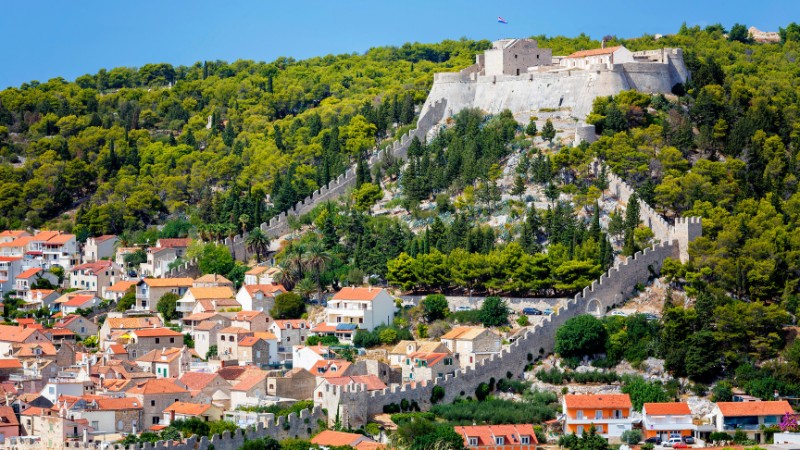
Take a Boat from Split to Hvar
Start your day early to catch the ferry from Split to Hvar. Here’s what you need to know:
- The ferry ride takes about an hour on a catamaran vessel or two hours if you take the car ferry.
- I recommend the catamaran for speed, but the car ferry offers great views of other islands of Croatia.
- Tickets can be bought online or at the ferry port, but I suggest you get them a day in advance to be safe.
- The ferry port is a short walk from Split’s old town, so you won’t need to take a taxi.
Climb Up to See Great Views of the Island
Once you arrive in Hvar Town, your first stop should be the Fortica (Španjola) Fortress. Here’s why it’s worth the climb:
- The walk up takes about 20 minutes. It’s a bit steep so take it slow and enjoy the views.
- From the top, you can see the whole of Hvar Town and the Pakleni Islands spread out before you.
- The fortress has interesting exhibits about the island’s history, including a collection of ancient amphoras.
- There’s a small cafe at the top where you can have a cold drink and soak in the view.
The Fortica fortress was built in the 16th century to protect the town from Turkish invasions. It’s a great place to start your visit as it gives you a bird’s eye view of where you’ll be exploring for the rest of the fourth day.
Explore Hvar Town and Find a Quiet Beach
After you come down from the Fortica fortress, explore Hvar Town. Here’s what you’ll see:
- St. Stephen’s Square: This is the main square and one of the largest in Dalmatia. The cathedral at one end is worth a look inside.
- Benedictine Monastery: This monastery is famous for its lace made from agave plants. The nuns have been making this lace for centuries.
- Hvar Theatre: One of the oldest in Europe, dating back to 1612 and it’s a beautiful building even if you can’t go inside.
After lunch at a local konoba (tavern) where you can try some Hvarska gregada (a local fish stew), you have two options:
- Relax on a nearby beach: Hvar Town has several small beaches within walking distance. They can be crowded in summer, but the water is beautifully clear.
- Take a taxi boat to the Pakleni Islands: These small islands just off Hvar have some of the most beautiful and secluded beaches I’ve ever seen. The boat ride takes about 15 minutes.
Experience Nightlife in Hvar
As the day winds down, head back to Hvar Town for dinner. There are lots of great restaurants with a terrace overlooking the harbor – the perfect spot to watch the sunset. Hvar is known for its nightlife, so if you’re up for it, you can check out some of the bars along the waterfront.
Day 5: Boat Trip to the Blue Cave and Other Islands
The fifth day in this Croatia itinerary is going to be an adventure on the Adriatic Sea! You’ll be taking a boat tour to see the famous Blue Cave and explore some of the most beautiful islands and bays in the area. This is always one of my favorite days of the trip.
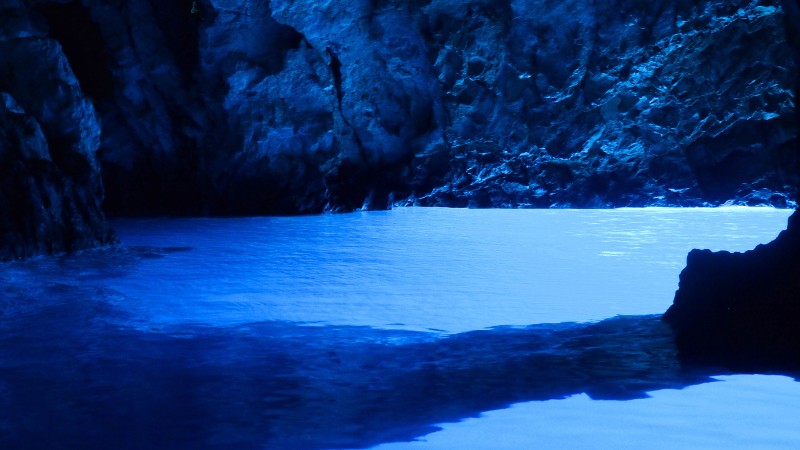
Go on a Boat Tour to See the Blue Cave
As always, start early in the morning to catch our boat tour. Here’s what you can expect:
- The tour usually lasts about 10-12 hours, so you’ll be out for most of the day.
- You’ll visit several islands and bays, with the Blue Cave as the highlight.
- The boat will have shade, but bring a hat and sunscreen as we’ll be in the sun a lot.
- Don’t forget your swimsuit and a towel – there will be plenty of swimming opportunities!
The Blue Cave is on the island of Biševo. It’s a sea cave that’s famous for the way sunlight enters it, creating a beautiful blue glow in the water. Here’s what visiting is like:
- You’ll transfer to a small boat to enter the cave, as the entrance is very low.
- The visit inside the cave is short (about 5-10 minutes) but truly magical.
- The best time to visit the Blue Cave is around midday when the sun is highest, creating the strongest blue effect.
Remember, the Blue Cave can sometimes be closed if the sea is too rough. But don’t worry – there are plenty of other beautiful spots on this tour!
Swim and Look at Fish in Clear Water
After the Blue Cave, your boat will take you to several beautiful bays and islands. Some of my favorite stops include:
- Stiniva Bay on Vis Island: This hidden cove is often voted one of the best beaches in Europe. The entrance is narrow, but it opens up into a beautiful pebble beach surrounded by cliffs.
- Green Cave on Ravnik Island: Another sea cave, but this one you can swim in! The light filtering through an opening in the ceiling gives the water a beautiful green color.
- Budikovac Island: This tiny island has a lagoon with incredibly clear water, perfect for swimming and snorkeling.
At each stop, have time to swim and snorkel. The water in this part of the Adriatic is incredibly clear – you can often see fish swimming around your feet!
Eat Fresh Fish on a Small Island
For lunch, your boat will stop at a small island – often Palmižana in the Pakleni Islands. Here’s what to expect:
- You’ll eat at a local restaurant right on the beach.
- The specialty is fresh grilled fish caught that morning. It’s simple but delicious!
- If you’re not a fish fan, there are usually meat and vegetarian options.
- Try some local white wine – the islands produce some excellent varieties.
Eating lunch with your feet in the sand, looking out at the blue Adriatic – for me, this is what a Croatian holiday is all about!
Spend the Rest of the Night in Hvar
After such a full day, you might be ready for a quiet evening. You can have a relaxed dinner in Hvar Town.
Find a restaurant that serves traditional Dalmatian peka (meat and vegetables cooked under an iron bell). If you’re still up for more, you could enjoy a drink at one of the bars along the harbor, watching the yachts come in for the night.
Day 6-7: Walk on Top of Dubrovnik’s Big Walls
We’ve reached the final stop on our Croatia itinerary – the stunning city of Dubrovnik. Often called the “Pearl of the Adriatic,” Dubrovnik is famous for its massive stone walls and beautiful old town. You’ll spend your last two days exploring this incredible city.

Get from Split to Dubrovnik
To reach Dubrovnik from Split, you have a few options:
- Bus: This is what I usually recommend. The journey takes about 4 hours and offers beautiful coastal views.
- Ferry: During summer, there’s a fast catamaran service. It takes about 4.5 hours but gives you a different perspective of the coast.
- Car rental: If you’re comfortable driving, this option gives you more flexibility to stop at places like Ston, famous for its oysters.
Whichever way you choose, you’ll arrive in Dubrovnik by early afternoon, giving you plenty of time to start exploring.
Walk Around Dubrovnik on Its Famous Walls
The highlight of any visit to Dubrovnik is walking the city walls. Here’s what you need to know:
- The full circuit is about 2 kilometers (1.2 miles) and takes 1-2 hours to complete.
- It’s best to go early in the morning or late in the afternoon to avoid the midday heat.
- Wear comfortable shoes and bring water – there are a lot of steps!
- The views are incredible – you’ll see the red roofs of the old town on one side and the bright blue Adriatic on the other.
As you walk, you’ll see some important landmarks that tell stories about Dubrovnik’s history. Did you know the city was an independent republic for centuries? It was so wealthy it rivaled Venice!
See Places from the TV Show Game of Thrones
If you’re a fan of Game of Thrones, you’ll recognize many spots in Dubrovnik because the city was used as a filming location for King’s Landing. Even if you haven’t seen the show, these places are fascinating:
- Jesuit Staircase: This baroque staircase was used for Cersei’s Walk of Shame. It’s beautiful in its own right.
- Fort Lovrijenac: Just outside the city walls, this fortress played the role of the Red Keep.
- Pile Gate: The main entrance to the old town which appears in many scenes as the entrance to King’s Landing.
You can also take a special Game of Thrones tour if you’re interested, or just visit these spots as part of your general exploration of the city.
Take a Day Trip to a Nearby Island or Town
On our second day in Dubrovnik, you have a few options for a day trip:
- Lokrum Island: Just a 15-minute boat ride from the old town, Lokrum is a nature reserve with beautiful gardens, peacocks roaming free, and great swimming spots.
- Cavtat: This charming small town is about 45 minutes south of Dubrovnik by boat. It’s much quieter than Dubrovnik and has lovely beaches and restaurants.
- Elaphiti Islands: A group of small islands near Dubrovnik. You can visit three of them (Koločep, Lopud, and Šipan) on a day tour, enjoying beaches and small villages.
My personal favorite is Lokrum because it’s close, beautiful, and offers a peaceful contrast to the busy streets of Dubrovnik.
Enjoy Your Final Night in Dubrovnik
For your last evening in Croatia, I suggest you watch the sunset from Mount Srđ. You can take the cable car up (or hike if you’re feeling energetic) and enjoy panoramic views of Dubrovnik and the surrounding islands. It’s a breathtaking way to say goodbye to this beautiful country.
After sunset, head back down to the old town for a farewell dinner. You can find many restaurants here that serves traditional Dalmatian cuisine with a modern twist. It’s the perfect spot to reflect on your amazing week in Croatia.
Goodbye Croatia: Remember Your Great Trip
I hope you’ve fallen in love with this country as much as I have. From the bustling streets of Zagreb to the peaceful lakes of Plitvice, from the historic palace in Split to the stunning islands of Hvar, and finally to the majestic walls of Dubrovnik – we’ve seen so much in just one week!
I bet you’re already thinking about when you can come back! There’s so much more to see in Croatia:
- The Roman amphitheater in Pula
- The beautiful beaches of Brač island
- The inland region of Slavonia with its folk traditions and wine
- The Istrian Peninsula, often called “Croatia’s Tuscany”
As you say goodbye, remember the Croatian phrase “Doviđenja” – it doesn’t just mean goodbye, but “until we see each other again.” And I’m sure you’ll be back to see more of beautiful Croatia!
How Many Days Is Enough for Croatia?
For a great experience in Croatia, plan for at least 7 to 10 days. This lets you visit highlights like Dubrovnik, Split, and Hvar, plus enjoy day trips to places like Plitvice Lakes and Krka National Parks. If you have more time, you can explore even more charming spots and hidden gems.
Where is the Best Place to Start in Croatia?
Start your trip to Croatia in Zagreb. The capital city boasts rich history, stunning architecture, and vibrant street life. You’ll find great museums, lively markets like Dolac Market, and a thriving coffee culture. Plus, Zagreb’s central location makes it easy to explore other parts of Croatia.
Is it Cheap to Travel to Croatia?
Traveling to Croatia can be affordable with good planning. A moderate budget is about €1000 to €1500 for a week, covering accommodation, meals, and activities. Budget travelers can manage on around €500 a week by staying in hostels, eating cheaply, and limiting paid activities. Popular spots like Dubrovnik can be pricier, so visit during the shoulder season to save money.
